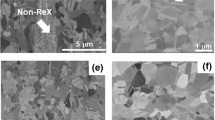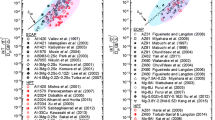Conclusions
-
1.
Reduction of the original grain size (before deformation) from 200 to ∼30 μ leads to an increase in the strength characteristics, electrical resistivity, and width of x-ray lines in deformed bronze Br. A7 and brass L68 and substantially increases the strengthening effect during subrecrystallization annealing.
TABLE 1
Alloy
ɛ, %
σ0
K
Br.A7
20
22/22
3,5/7,0
50
41/60
2,0/4,5
75
44/75
0,5/4,0
L68
20
28/28
1,0/2,0
50
38/50
0,5/1,5
75
42/60
0,5/2,0
-
2.
With increasing deformation the effect of the grain size on the elastic limit decreases, while the effect on the ultimate strength and yield strength remains almost unchanged. After annealing, the effect of the original grain size on the strength characteristics increases spharply as compared with the deformed condition.
-
3.
Subrecrystallization annealing sharply increases the resistance to deformation of the grain boundaries, and in alloys deformed 50 and 75% substantially increases the resistance to deformation in slip bands.
Similar content being viewed by others

Literature cited
Hasiguti, Nippon Kinzoku Gakkaishi,19, No. 2, 103 (1955).
Kato et al., Nippon Kinzoku Gakkaishi,20, No. 4, 234 (1956).
N. P. Gorlenko et al., "Effect of grain size on the properties of strain-hardening spring alloys based on copper," in: Electrical Alloys [in Russian], Trudy Inst. GIPROT sVET METOBRABOTKA, No. 41 (1974), p. 68.
E. Hall, Proc. Phys. Soc. (London),64, 747 (1951).
Ya. D. Vishnyakov, B. R. Gorobets, and M. N. Peregudov, "Structure of copper-based alloys after deformation at different temperatures," in: Plastic Deformation of Metals and Alloys [in Russian]. Trudy MISIS,57 (1970), p. 233.
H. Conrad and S. Fenerstein, Rice L. Mater. Sci. Eng.2, 157 (1967).
Additional information
State Scientific-Research and Design Institute of Alloys and Treatment of Nonferrous Metals. N. É. Bauman Moscow Technical College. Translated from Metallovedenie i Termicheskaya Obrabotka Metallov, No. 3, pp. 38–41, March, 1977.
Rights and permissions
About this article
Cite this article
Gorlenko, N.P., Rakhshtadt, A.G., Rozenberg, V.M. et al. Effect of original grain size on structure and properties of copper alloys after deformation and annealing. Met Sci Heat Treat 19, 204–207 (1977). https://doi.org/10.1007/BF01167001
Issue Date:
DOI: https://doi.org/10.1007/BF01167001



